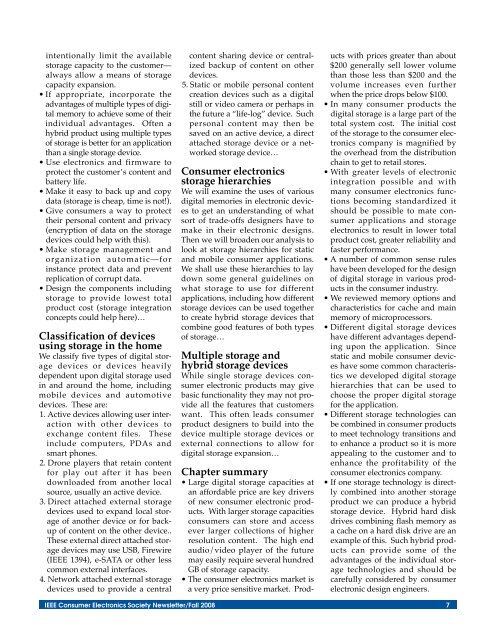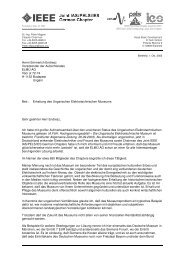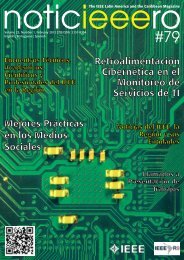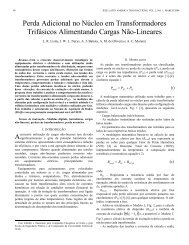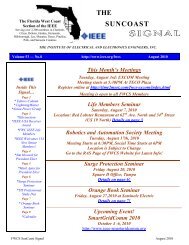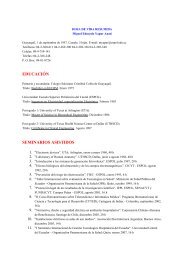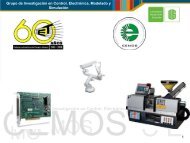continued from page 1 - IEEE Entity Web Hosting IEEE Entity Web ...
continued from page 1 - IEEE Entity Web Hosting IEEE Entity Web ...
continued from page 1 - IEEE Entity Web Hosting IEEE Entity Web ...
You also want an ePaper? Increase the reach of your titles
YUMPU automatically turns print PDFs into web optimized ePapers that Google loves.
intentionally limit the available<br />
storage capacity to the customer—<br />
always allow a means of storage<br />
capacity expansion.<br />
• If appropriate, incorporate the<br />
advantages of multiple types of digital<br />
memory to achieve some of their<br />
individual advantages. Often a<br />
hybrid product using multiple types<br />
of storage is better for an application<br />
than a single storage device.<br />
• Use electronics and firmware to<br />
protect the customer’s content and<br />
battery life.<br />
• Make it easy to back up and copy<br />
data (storage is cheap, time is not!).<br />
• Give consumers a way to protect<br />
their personal content and privacy<br />
(encryption of data on the storage<br />
devices could help with this).<br />
• Make storage management and<br />
organization automatic—for<br />
instance protect data and prevent<br />
replication of corrupt data.<br />
• Design the components including<br />
storage to provide lowest total<br />
product cost (storage integration<br />
concepts could help here)…<br />
Classification of devices<br />
using storage in the home<br />
We classify five types of digital storage<br />
devices or devices heavily<br />
dependent upon digital storage used<br />
in and around the home, including<br />
mobile devices and automotive<br />
devices. These are:<br />
1. Active devices allowing user interaction<br />
with other devices to<br />
exchange content files. These<br />
include computers, PDAs and<br />
smart phones.<br />
2. Drone players that retain content<br />
for play out after it has been<br />
downloaded <strong>from</strong> another local<br />
source, usually an active device.<br />
3. Direct attached external storage<br />
devices used to expand local storage<br />
of another device or for backup<br />
of content on the other device..<br />
These external direct attached storage<br />
devices may use USB, Firewire<br />
(<strong>IEEE</strong> 1394), e-SATA or other less<br />
common external interfaces.<br />
4. Network attached external storage<br />
devices used to provide a central<br />
content sharing device or centralized<br />
backup of content on other<br />
devices.<br />
5. Static or mobile personal content<br />
creation devices such as a digital<br />
still or video camera or perhaps in<br />
the future a “life-log” device. Such<br />
personal content may then be<br />
saved on an active device, a direct<br />
attached storage device or a networked<br />
storage device…<br />
Consumer electronics<br />
storage hierarchies<br />
We will examine the uses of various<br />
digital memories in electronic devices<br />
to get an understanding of what<br />
sort of trade-offs designers have to<br />
make in their electronic designs.<br />
Then we will broaden our analysis to<br />
look at storage hierarchies for static<br />
and mobile consumer applications.<br />
We shall use these hierarchies to lay<br />
down some general guidelines on<br />
what storage to use for different<br />
applications, including how different<br />
storage devices can be used together<br />
to create hybrid storage devices that<br />
combine good features of both types<br />
of storage…<br />
Multiple storage and<br />
hybrid storage devices<br />
While single storage devices consumer<br />
electronic products may give<br />
basic functionality they may not provide<br />
all the features that customers<br />
want. This often leads consumer<br />
product designers to build into the<br />
device multiple storage devices or<br />
external connections to allow for<br />
digital storage expansion…<br />
Chapter summary<br />
• Large digital storage capacities at<br />
an affordable price are key drivers<br />
of new consumer electronic products.<br />
With larger storage capacities<br />
consumers can store and access<br />
ever larger collections of higher<br />
resolution content. The high end<br />
audio/video player of the future<br />
may easily require several hundred<br />
GB of storage capacity.<br />
• The consumer electronics market is<br />
a very price sensitive market. Prod-<br />
ucts with prices greater than about<br />
$200 generally sell lower volume<br />
than those less than $200 and the<br />
volume increases even further<br />
when the price drops below $100.<br />
• In many consumer products the<br />
digital storage is a large part of the<br />
total system cost. The initial cost<br />
of the storage to the consumer electronics<br />
company is magnified by<br />
the overhead <strong>from</strong> the distribution<br />
chain to get to retail stores.<br />
• With greater levels of electronic<br />
integration possible and with<br />
many consumer electronics functions<br />
becoming standardized it<br />
should be possible to mate consumer<br />
applications and storage<br />
electronics to result in lower total<br />
product cost, greater reliability and<br />
faster performance.<br />
• A number of common sense rules<br />
have been developed for the design<br />
of digital storage in various products<br />
in the consumer industry.<br />
• We reviewed memory options and<br />
characteristics for cache and main<br />
memory of microprocessors.<br />
• Different digital storage devices<br />
have different advantages depending<br />
upon the application. Since<br />
static and mobile consumer devices<br />
have some common characteristics<br />
we developed digital storage<br />
hierarchies that can be used to<br />
choose the proper digital storage<br />
for the application.<br />
• Different storage technologies can<br />
be combined in consumer products<br />
to meet technology transitions and<br />
to enhance a product so it is more<br />
appealing to the customer and to<br />
enhance the profitability of the<br />
consumer electronics company.<br />
• If one storage technology is directly<br />
combined into another storage<br />
product we can produce a hybrid<br />
storage device. Hybrid hard disk<br />
drives combining flash memory as<br />
a cache on a hard disk drive are an<br />
example of this. Such hybrid products<br />
can provide some of the<br />
advantages of the individual storage<br />
technologies and should be<br />
carefully considered by consumer<br />
electronic design engineers.<br />
<strong>IEEE</strong> Consumer Electronics Society Newsletter/Fall 2008 7


